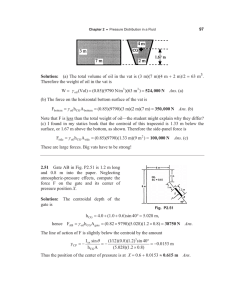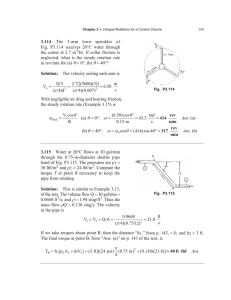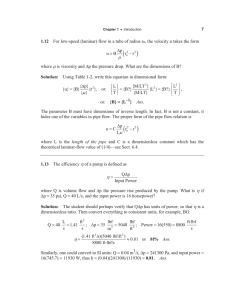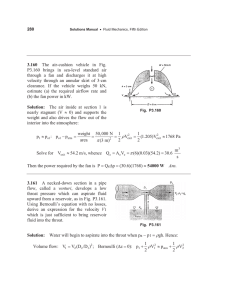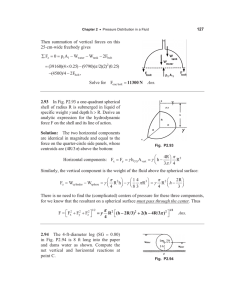J
advertisement
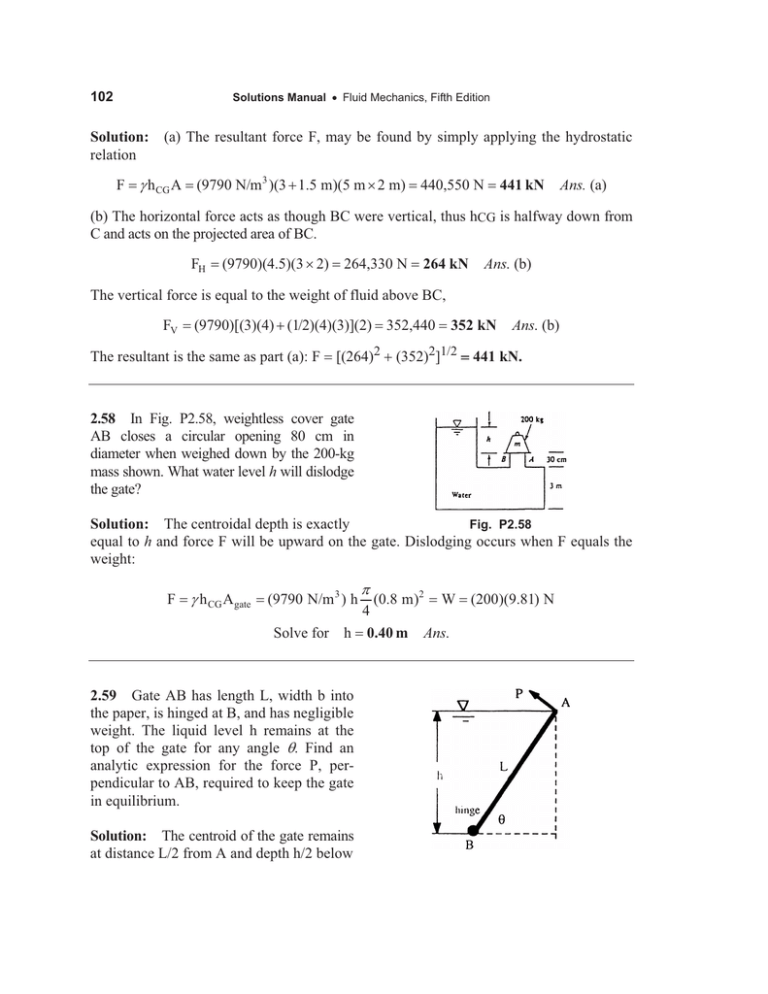
102 Solutions Manual x Fluid Mechanics, Fifth Edition Solution: (a) The resultant force F, may be found by simply applying the hydrostatic relation F J h CG A (9790 N/m 3 )(3 1.5 m)(5 m u 2 m) 440,550 N 441kN Ans. (a) (b) The horizontal force acts as though BC were vertical, thus hCG is halfway down from C and acts on the projected area of BC. FH (9790)(4.5)(3 u 2) 264,330 N 264kN Ans. (b) The vertical force is equal to the weight of fluid above BC, FV (9790)[(3)(4) (1/2)(4)(3)](2) 352,440 The resultant is the same as part (a): F 352kN [(264)2 (352)2]1/2 Ans. (b) 441 kN. 2.58 In Fig. P2.58, weightless cover gate AB closes a circular opening 80 cm in diameter when weighed down by the 200-kg mass shown. What water level h will dislodge the gate? Solution: The centroidal depth is exactly Fig. P2.58 equal to h and force F will be upward on the gate. Dislodging occurs when F equals the weight: F J h CG A gate (9790 N/m 3 ) h S (0.8 m)2 W 4 Solve for h 0.40 m Ans. 2.59 Gate AB has length L, width b into the paper, is hinged at B, and has negligible weight. The liquid level h remains at the top of the gate for any angle T. Find an analytic expression for the force P, perpendicular to AB, required to keep the gate in equilibrium. Solution: The centroid of the gate remains at distance L2 from A and depth h2 below (200)(9.81) N 103 Chapter 2 x Pressure Distribution in a Fluid the surface. For any T, then, the hydrostatic force is F J (h2)Lb. The moment of inertia (112)bL3sinT[(h2)Lb], and the center of of the gate is (112)bL3, hence yCP pressure is (L2 yCP) from point B. Summing moments about hinge B yields PL F(L/2 y CP ), or: P = J hb/4 L L2 sin T /3h Ans. P2.60 In 1960, Auguste and Jacques Picard’s self-propelled bathyscaphe Trieste set a record by descending to a depth of 35,800 feet in the Pacific Ocean, near Guam. The passenger sphere was 7 ft in diameter, 6 inches thick, and had a window 16 inches in diameter. (a) Estimate the hydrostatic force on the window at that depth. (b) If the window is vertical, how far below its center is the center of pressure? Solution: At the surface, the density of seawater is about 1025 kg/m3 (1.99 slug/ft3). Atmospheric pressure is about 2116 lbf/ft2. We could use these values, or estimate from Eq. (1.19) that the density at depth would be about 4.6% more, or 2.08 slug/ft3. We could average these two to 2.035 slug/ft3. The pressure at that depth would thus be approximately p p a U avg g h 2116 (2.035 slug )(32.2 ft J sin T I xx F [2.035 * 32.2 lbf ft ] sin(90 D ) 3 2 )(35800 ft ) | 2,350,000 lbf ft s ft 2 (a) This pressure, times the area of the 16-inch window, gives the desired force. lbf S 16 (2350000 2 )[ ( ft ) 2 ] Fwindow pCG A 3,280,000 lbf Ans.(a ) 4 12 ft Quite a lot of force, but the bathyscaphe was well designed. (b) The distance down to the center of pressure on the window follows from Eq. (2.27): yCP 3 (S / 4)(8 / 12 ft ) 4 3280000 lbf 3.2E 6 ft. Ans.(b) The center of pressure at this depth is only 38 micro inches below the center of the window.
